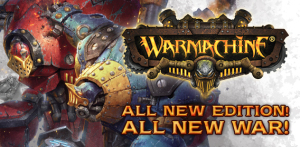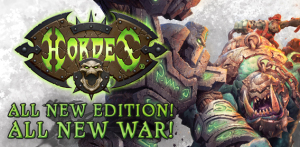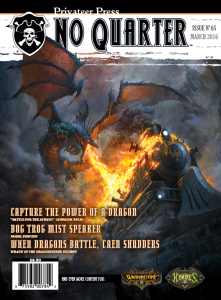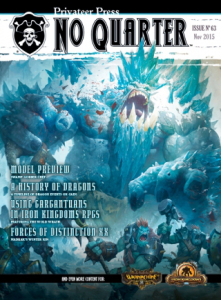Aeryn Rudel's Blog, page 64
May 4, 2016
April 2016 Submission Statement
April has come and gone, and it was a pretty decent month as far as the ol’ writing gig goes. I wasn’t as productive as I would have liked, andI sent out only five submissions, but since I was working on some big writing projects like this one, I don’t feel too bad about it.
March Report Card
Submissions Sent: 5 Rejections: 5 Acceptances: 1 Other: 0 Publications: 2 The RejectionsFirst, the usual slew of rejections.Five this month.
Rejection 1: 4/2/16
Thank you for submitting your story “XX...
April 29, 2016
First Shots Fired: An Author Interview at Privateer Press
My first Iron Kingdoms novel, Acts of War: Flashpoint, drops in June, and the fine folks over at Privateer Press have gone and plastered my smiling mug on their website along with an interview about the book. If you have a sec, hop on over and read it, and, if you’re unfamiliar, learn a bit more about the steam-powered fantasy setting of the Iron Kingdoms.
Click on thebadass cover artbelow for the interview.


April 27, 2016
Rejection Letter Rundown: The Short List Rejection
Sometimes you have to wait a while for a publisher to get back to you about a submission, which can be hard, but it’s just one of those things you have to accept as part of the whole being a writer thing. That said, when you have good reason to hope your story will be accepted, the waiting can become rather nail-biting and the possible rejection all the more disappointing. Today’s rejection letter du jour is the short list rejection, which is a whole process that begins with an encouraging no...
April 20, 2016
Take a Quiz, Get a Free Story from Privateer Press
Some of you might recall that I’m writing a series of novels for my former employer, Privateer Press, set in their Iron Kingdoms universe. Why am I reminding you? Well, Privateer Press has announced new editions of their award-winning tabletop miniature games WARMACHINE and HORDES, which means it’s a great time to get acquainted with the games or the steam-powered fantasy setting they inhabit. On top of that, the novels I’m currently writing form a large part of the new narrative for the games, telling the story of some of the Iron Kingdoms greatest heroes and villains as they adapt to a dangerous new world.
So here’s what I’d like you to do. Go to the Privateer Press presentation website for the new editions of WARMACHINE and HORDES, click “Find out More,” scroll through some awesome illustrations and photos of the game until you get to a screen that says “Take the Quiz.” Click “Take the Quiz,” and at the end of the quiz, sign up to receive a free short story from Privateer Press every Thursday. Tomorrow, you’ll get a story from yours truly (plus two more from me in the coming weeks).
Here’s the link to the presentation site: ALL NEW WAR
Or, if you want to skip all that jazz and go right to the quiz, click this link: TAKE THE QUIZ
Thanks for playing along, and I hope you dig the story.


April 11, 2016
Good Hookers are Hard to Find
There’s some click bait for you, huh? Did I get you? Well, unfortunately, like most click bait, this post is not what you think it is. Let me explain.
A while back, a friend gave me a great book by Stephen King called Secret Windows, a collection of essays and fiction about writing (sadly, it’s now out of print). I think my favorite essay in the book (and there are a bunch of good ones) is called “Great Hookers I have Known.” The essay is about writing a truly gripping first sentence in a novel or short story, which were apparently called “hookers” by publishers back in the day. It’s the sentence that grabs the reader and tells him or her, “Hey, this story might actually be worth reading.”
Anyway, in the essay, King goes to his own published works and discovers he’s not particularly good at writing hookers (Totally tanked his career, right?), then cites some sterling examples of the art, no few of which come from Elmore Leonard. He also points out that hookers are more important in short stories, and I couldn’t agree more. I mean, you’ve got to get that editor’s attention fast, and a top-rate, attention-grabbing first line is a good way to do it.
So, like King, I went to my (much, much smaller and far, far less prestigious) collection of published works to see if I had come up with any good hookers. Well, it’s a bit of a mixed bag, a few good ones and a few not so good. Let’s look at the bad first.
Here’s one from a story I recently published called “Scare Tactics,” a story I really like. It’s a wonder it sold at all with this yawn-inducing first line.
Lindsey pulled up to the curb, killed the Accord’s engine, and glanced out the passenger-side window.
Wow, boring, right? Curbs and Hondas and passenger-side windows. Bleh. It’s not a bad sentence, I guess, but it sure as fuck ain’t an exciting one. I think its biggest sin is that it tells you absolutely nothing about the story that comes after it. This could be any genre, and it could be set just about anywhere. I swear, the story gets a lot better from here, but I got a bunch of rejections on this one before it sold.
This one is from a flash story called “The Rarest Cut.” I don’t think it’s as bad as my first example, but it’s not gonna win any prizes.
Vincent cut into the meat on his plate, sliced off a small portion, then lifted the morsel to his nose and sniffed.
Sure, you get the idea that this story is gonna have some eating in it, but that first sentence is just kind of sitting there being unexciting. This story also racked up a bunch of rejections before I finally placed it. Seeing a trend here yet?
Finally, this one is from a flash piece called “At the Seams.” This is one of my favorite pieces, but, man, I didn’t do it any favors with this first sentence.
It’s getting harder to maintain focus.
Maintain focus on what? The problem here is it’s just too damn vague. It’s also uninteresting. This sentence is in desperate need of some spice, something that says to the reader, “Hey, fucking NOTICE me!” This story holds my personal record for rejections, racking up thirteen before I placed it.
Let me state for the record I think all three of these stories are good ones, and I did manage to get them published. That said, they were rejected a lot. Was that because of a bad hooker? Hard to say, but if I was running into editors who were bored by the first sentence, maybe they lost interest in the story and didn’t read much of it before hitting the ol’ reject button. The wonderful, kind, and gracious folks who did publish these stories might have pushed past my weak opening line to find something they liked further in. Again, this is all conjecture, but let’s see if I can’t find more evidence for “good hookers are a must” with some other stories.
Okay, here are some of the “best” hookers from my published works. I put best in quotes because this is a pretty subjective exercise.
This first hooker is from “Night Games,” which I personally think is the best story I’ve published to date (your mileage may vary).
Randall Simmons only plays night games.
Hey, that’s not too bad, right? I mean, I hope it has you asking, “Who is this Randall Simmons guy, and why does he only play night games?” I think that’s the key to a good hooker; it gets the reader asking questions. This line also says you’re in for a sports story (even if you’re only passing familiar with such things) and this Randall dude might be up to something. I hope all that adds up to you wanting to read more. This story was rejected a couple of times, but it was also short listed once and it received almost entirely personal notes from editors, usually citing the baseball stuff as a little to sporty for their market. I also managed to sell it as a reprint to a pro-paying market on the first try. Not too bad.
This next one is from a flash piece called “Side Effects.”
Harold approached the final electrical outlet in the living room, a roll of duct tape in one hand, his bottle of Clozaril in the other.
Yeah, I dig this one. It tells you some shit right off the bat, and I think it would get most readers asking questions. I think phrases like “final electrical outlet” and “roll of duct tape” come together to paint an interesting image. But, in my opinion, what keeps this from being a really great hooker is most folks won’t know that Clorazil is an antipsychotic medication. If I could have found some way to make that more clear, I might have had a real winner on my hands. Still, I placed this story with the first publisher who read it.
Okay, this last hooker is probably my best. It’s from a story called “One Last Spell, My Love,” which you can read right here on this blog.
How do you break up with a demon?
There’s a lot of flavor packed into that little bastard, huh? I mean, I just told you you’re gonna read a story with a demon, someone in a romantic relationship with said demon, and, holy fuck, someone who’s gonna kick that demon to the curb. That’s a story I would want to read. Again, I think what makes this a good hooker is that it gets the reader asking questions, probably just one, “How DO you break up with a demon?” This story also sold quickly. In its first submission run, I sim-subbed it to two publishers, and one of those publishers bought it.
So, have I proved you need a good hooker to sell a short story? Nope; in fact, I may have provided evidence that if you’re patient, you can have a crap first line and still sell a story. I think, however, I may have delivered a little anecdotal evidence that a good hooker helps you sell a story quicker, maybe. Again, this is all conjecture and opinion, and I invite you to draw your own conclusions.
Got any good hookers of your own? I’d love to read them in the comments.


April 6, 2016
Rejection Letter Rundown: The Referral Rejection
In the hierarchy of “good” rejections, the referral rejection has got to be near the top. What is it? It’s a personal note from an editor often telling you why they didn’t accept your story and then referring you to another market that might. Pretty cool, right? Here’s one I recently received.
Thank you for submitting your story “XXX” to XXX, but we’re going to take a pass on this one.
Not quite enough horror in this, I’m afraid, but I’m betting the folks at XXX will really like it: [link to referred site]. You might try this story with them.
By the way, I’m super stoked about “XXX.” Keep sending stuff our way!
A quick note before I break this down. This market recently accepted a story of mine (you can probably tell that much from the letter).
Okay, here are some good things about this rejection. One, they tell my straight up why they didn’t take it. “Not enough horror” are three words that tell me A LOT. My story had horror elements, but is likely closer to dark urban fantasy than straight horror. It really gives me a good idea what to send them in the future, especially now that I can compare the story they accepted with this rejection. Two, it’s fair to say they liked the story, and the referral is to a fantasy market affiliated with them. Three, the last sentence is a legit invite to send them more stuff; that always great.
As you can guess, I fired this story off to the suggested market immediately. I feel pretty confident about it, but, you know, there’s no guarantees in publishing. Still, I like my chances with this submission a bit better than most.
If you’ve received a referral rejection, I’d love to hear about it in the comments.


April 1, 2016
March 2016 Submission Statement
I was unable to follow up on February’s success in March, and all my stats are down. That said, my flagging production was for a good cause. I spent most of March finishing and revising my first novel for Privateer Press, due out this summer. Anyway, here’s how the month broke down.
March Report Card
Submissions Sent: 3
Rejections: 2
Acceptances: 0
Other: 0
Publications: 1
The Rejections
Rejection’s first. There’s only two this time.
Rejection 1: 3/12/16
Thank you for submitting to XXX. We have decided not to publish your piece, “XXX”. Some reader comments:
“Although the idea is interesting, it starts slowly and doesn’t end with any closure. I don’t see a full story here.”
“I found the first sentence ungainly. This scene gives no indication of something I can take away (other than ‘the bad thing kills people and goes away to kill more’). I needed the kind of content and context which would make these happenings important to me.”
“The story isn’t complete.”
“Didn’t hook me in, and didn’t pace quickly enough for a flash, in my opinion. I didn’t feel I really got to know these characters enough to invest in what’s going on here (they were fairly stock to me; types, not individuals). This reads more like a solid excerpt from a commercial novel more than a flash. Not really my cup of tea.”
“I’d have liked this a lot more if there were an explanation to what the “fire” is. It’s an interesting enough premise, but it feels incomplete to me.”
Best of luck, and please feel free to submit to us again in the future.
That’s a long one, eh? It’s a type of rejection I call the multi-reader rejection, and there’s some pretty good feedback in here. I covered this rejection and the multi-reader rejection letter earlier this month in this post.
Rejection 2: 3/30/16
Thank you for submitting “XXX.” Unfortunately, this didn’t quite work for me, so I’m going to pass this time.
This is your common, garden-variety form letter. It’s from a market I’ve submitted to once before (with the same result). I think it bears repeating that you should not read anything into a letter like this because it doesn’t tell you anything (other than no). There’s no point in overanalyzing phrases like “didn’t quite work for me” because they are essentially meaningless without further details. So, this is a letter you let roll off your back while you fire that story off to another publisher.
The Publications
So, only one other thing of note this month. I had a reprint story published with Digital Fiction Pub called “Night Walk.” You can read it by clicking the link below.
And that, folks, was my March 2016. What did yours look like?


March 30, 2016
My Merciless Masters at No Quarter Magazine
As some of you may know, I do a lot of work for Privateer Press, a tabletop gaming company responsible for the award-winning fantasy miniature games WARMACHINE and HORDES. Privateer is also my former employer, and one my positions there was editor-in-chief of their in-house magazine No Quarter. The magazine is now in the very able hands of my former colleague Lyle Lowery, and, since he’s such a nice guy, he lets me write for the magazine on a pretty regular basis.
The most recent issue of No Quarter features an article of mine called “Guts & Gears: Blind Walker.” The Guts & Gears series is kind of like an encyclopedia entry for the strange and terrible monsters and machines that inhabit the Iron Kingdoms, the setting for the WARMACHINE and HORDES games. The one I wrote for this issue is about a giant, bipedal gator monster augmented by terrible necromantic rituals to serve its reptilian masters. Here are the covers of the last two issues I worked on (including the most recent).
For over ten years No Quarter magazine has provided the Privateer Press community with a wealth of informative articles, top-notch fiction, and sneak previews into upcoming developments in Privateer’s many award-winning games. The magazine, of course, holds special significance for me since I guided its course for three years. It was one of the most rewarding and challenging jobs I’ve held. One of these days I’ll write about my experiences running No Quarter. The uncompromising schedule of a magazine is a terrifying but educational experience for anyone who wants to work in a creative field.


March 28, 2016
Writing for Dollars: 4 Tiers of Freelance Payment
Getting published usually means getting paid for your work. Getting paid is a good thing, even if you’re “not doing it for the money.” At the very least, it’s some validation your writing is actually worth something. To further illustrate my feelings on the subject, I’ll quote one of my favorite authors again:
“If you wrote something for which someone sent you a check, if you cashed the check and it didn’t bounce, and if you then paid the light bill with the money, I consider you talented.”
— Stephen King
Note, all the info I’m going to present in this post is based on my experience publishing short stories in the genre market. It may not apply to the literary or the non-fiction markets, so if you write in either of those, this post may be of dubious value to you. Just saying.
How much you get paid when publishing short stories in the genre fiction market depends, of course, on where you publish. Some publishers pay nothing, some pay a little, and some pay all the way up to 10 cents per word and more. As you can imagine, it’s tougher to get published by the guys paying 10 cents per word.
From my experience, there are four basic tiers of payment in the genre market: exposure only, token, semi-pro, and professional. Only the first and last are clearly defined. The two in the middle are a bit of a mixed bag.
Exposure Only: These publications pay nothing. Some might send you a print or digital contributor copy, but many don’t, so it really is nada. The vast majority of small online fiction zines fall into this category, and a quick search at Duotrope reveals that nearly 50% of the markets that publish short horror fiction, for example, are exposure-only markets.
Token Payment: Just like it sounds, these markets pay a very small amount. In my experience, this is often not a per-word rate; it’s a flat fee somewhere between five and fifteen bucks. It’s important to note that fifteen bucks for a 1,000-word flash story works out to about 1.5 cents per word, which is semi-pro payment. In other words, some of these token markets technically pay semi-pro rates if the story is short enough.
Semi-Pro Payment: Okay, now we’re starting to hit the money, relatively speaking. The definitions I’ve seen usually define semi-pro payment at 1 cent per word to 5 cents per word. There are quite a few semi-pro markets that pay toward the lower end of that scale, usually 1 cent per word. Pro-paying markets might also pay semi-pro rates for reprints, which is something I’ve seen from time to time.
Pro Payment: Now we’re in the big time. This category is probably the best defined because well-respected professional writer organizations, like the SFWA (Science Fiction & Fantasy Writers of America), have set a minimum amount a publication must pay to be considered a qualifying professional market, meaning if you get published there it counts a qualifying publication for membership in the SFWA. Anyway, that minimum payment is 6 cents per word, and as you can guess, there aren’t many markets that pay that much, and those that do are tough to crack. Two pro markets I’ve been trying to break through with for some time are Daily Science Fiction and Clarkesworld , which pay 8 cents and 10 cents per word, respectively.
Now that we’ve talked about what you might get paid, let’s talk about how you might get paid. Many semi-pro and pro markets are quite happy to send you a check, but nearly all the token markets and quite a few of the semi-pro markets prefer PayPal. In fact, some will only pay you through PayPal. So, if you don’t have a PayPal account, get one. It’s free, it’s not difficult to set up, and you can often use PayPal funds like a debit card or simply transfer the money into your bank account (though it takes like five business days).
You should also keep track of how much you’re getting paid, via a spreadsheet or accounting software. If you make over $400.00 in a year as a freelance writer, you have to claim that on your taxes, so you should definitely keep track. I’m not a CPA, so you shouldn’t take anything I say about taxes as gospel (I could easily be wrong). Susan Lee, EA, CFP, on the other hand, is someone you can and should listen to. She offers a ton of useful advice for freelancers of all types on her site FreelanceTaxation.com.
Got more info on reaping the vast riches from a freelance writing career? Did I post something factually inaccurate? Tell me about either in the comments.


March 23, 2016
Ghost Story Apocalypse: My Latest Publication
Hey, all, you can read my flash fiction story “Night Walk” over at Digital Fiction Pub. This one is a reprint, and its first appearance was in the Molotov Cocktail’s Flash Future contest, where it took second place. Some of you have already read it, but for those who haven’t, it’s a spooky little piece about ghosts and the end of the world and stuff. Link below.
READ MY STORY
Check it out, and let me know what you think in the comments.










